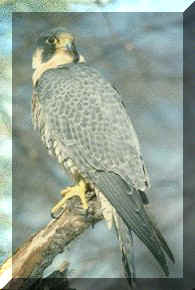

Peregrine Falcon
Status: Two
subspecies are endangered: American (F. peregrinus anatum) and Eurasian (f.
peregrinus peregrunus). Arctic subspecies (F. peregrinus tundrius) is
threatened. However, many populations have made a dramatic comeback.
Description: Medium
sized bird of prey with long pointed wings and a long tail. Adults have blue-gray backs
and white faces usually with a black stripe on each side, and large, dark eyes.
Size: Length: 15-20
inches from head to tail. Wingspan: 3 feet. Females larger than males.
Habitat: Mountain
ranges, river valleys, coastal areas. Sometimes build aeries (nests) on tall buildings in
cities.
Range:
F. peregrinus: worldwide, except Antarctica and Pacific Islands.
F. peregrinus anatum: nests from central Alaska across north central Canada to
central Mexico, winters south to South America.
F. peregrinus tundrius: nests from northern Alaska to Greenland; winters south to
Central and South America.
F. peregrinus peregrinus: Europe, Eurasia south to Africa and Mideast.
Food Source: Primarily
starlings, jays, pigeons, shorebirds, and some ducks.
Behavior: Male
performs aerial acrobatics to attract mate. Female lays several eggs in late spring which
hatch one month later. Young mature at 2 years.
Survival Threats: Habitat
loss; continued use of DDT in many Latin American countries where the falcon winters. DDE,
a by-product of DDT, weakens eggshells, causing them to break during brooding.
Legal Protection: CITES
Appendix I, Migratory Bird Conservation Act, Endangered Species Act.
Conservation: Banning use of DDT, captive
breading and reintroduction, public education, field research. Over 3,000 peregrines have
been released in 28 states since mid-1970's.
